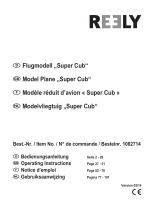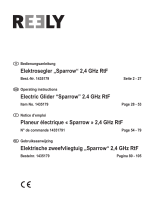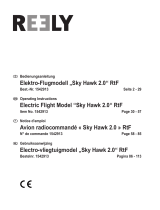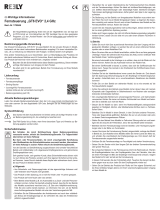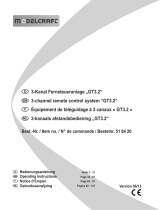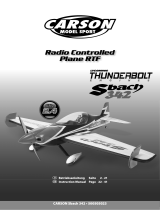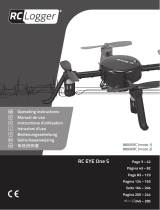Page is loading ...

Bedienungsanleitung
Elektro-Flugmodell „Micro Beaver“ RtF
Best.-Nr. 1490800 Seite 2 - 27
Operating Instructions
Electric Flight Model “Micro Beaver“ RtF
Item No. 1490800 Page 28 - 53
Notice d’emploi
Avion radiocommandé « Micro Beaver » RtF
N° de commande 1490800 Page 54 - 79
Gebruiksaanwijzing
Electro-vliegtuigmodel „Micro Beaver“ RtF
Bestelnr. 1490800 Pagina 80 - 105

28
Table of Contents
1. Introduction ........................................................................................................................................................ 30
2. Explanation of Symbols .....................................................................................................................................30
3. Intended Use .....................................................................................................................................................31
4. Product Description ...........................................................................................................................................31
5. Scope of Delivery ...............................................................................................................................................31
6. Safety Information ..............................................................................................................................................32
a) General Information .....................................................................................................................................32
b) Before Commissioning ................................................................................................................................32
c) During Operation .........................................................................................................................................33
7. Information on Batteries and Rechargeable Batteries ....................................................................................... 34
8. Transmitter Controls ..........................................................................................................................................36
9. Setting up the Transmitter ..................................................................................................................................37
a) Inserting the Batteries ..................................................................................................................................37
b) Checking the Transmitter‘s Power Supply ..................................................................................................38
10. Charging the Flight Battery ................................................................................................................................ 39
11. Inserting/Connecting the Flight Battery ..............................................................................................................40
12. Renewing the Transmitter/Receiver Binding ......................................................................................................41
13. Basic Settings of the Digital Trim ...................................................................................................................... 42
14. Servo Reserve and Motor Deactivation ............................................................................................................. 43
a) Servo Reverse .............................................................................................................................................43
b) Motor Deactivation .......................................................................................................................................44
15. Checking the Control Functions .........................................................................................................................45
a) Motor Function .............................................................................................................................................45
b) Neutral Position ...........................................................................................................................................46
c) Elevator Function ........................................................................................................................................46
d) Rudder Function .......................................................................................................................................... 47
16. The First Flight ................................................................................................................................................... 48
a) Take-Off ....................................................................................................................................................... 48
b) Curve Flight .................................................................................................................................................48
c) Trimming the Model ..................................................................................................................................... 49
d) The First Touch-Down .................................................................................................................................49
Page

29
17. Maintenance and Care .....................................................................................................................................50
18. Disposal ............................................................................................................................................................. 51
a) Product ........................................................................................................................................................51
b) Batteries/Rechargeable Batteries ................................................................................................................51
19. Declaration of Conformity (DOC) ....................................................................................................................... 51
20. Troubleshooting .................................................................................................................................................52
21. Technical Data ...................................................................................................................................................53
a) Transmitter...................................................................................................................................................53
b) Flight Model ................................................................................................................................................. 53
c) Flight Battery ...............................................................................................................................................53
Page

30
1. Introduction
Dear Customer,
thank you for purchasing this product.
This product complies with the statutory national and European requirements.
To maintain this status and to ensure safe operation, you as the user must observe these operating instructions!
These operating instructions are part of this product. They contain important notes on commissioning and
handling. Also consider this if you pass on the product to any third party.
Therefore, retain these operating instructions for reference!
All company names and product names are trademarks of their respective owners. All rights reserved.
If there are any technical questions, please contact:
International: www.conrad.com/contact
United Kingdom: www.conrad-electronic.co.uk/contact
2. Explanation of Symbols
The symbol with the exclamation mark points out particular dangers associated with handling, function or
operation.
The arrow symbol indicates special advice and operating information.

31
3. Intended Use
This product is an electrically powered motor model airplane with wireless radio control via the remote control system
included in the delivery. The model is designed for use in suitable halls and must only be used on perfectly wind-still
days outside because of its low weight. The model airplane is pre-assembled and is delivered with built-in remote
control and drive components.
The product must not become damp or wet.
The product is not suitable for children under 14 years of age.
Observe all safety information in these operating instructions. They contain important information on hand-
ling of the product.
You are solely responsible for safe operation of the model!
4. Product Description
Theightmodel„MicroBeaver“isapre-fabricatedRtFmodel(ReadytoFly),thatisreadyforusewithjustafewsteps.
All drive and control components are built-in and ready for use. The model is controlled via an easy-to-operate radio
remote control system.
For operation of the remote control system, 4 AA/mignon batteries (e.g. Conrad item no.: 652504, pack of 4, order
1x) are required.
Thetwooperatingleversattheremotecontrolareusedtocontrolmotorspeed,ightheightandightdirection.
The LiPo battery to be inserted in the model is charged with the included remote control transmitter.
5. Scope of Delivery
• Plane Model
• Remote control transmitter 2.4 GHz
• LiPo Flight Battery
• Replacement propeller
• Operating Instructions
Current operating instructions
Download the current operating instructions via the link www.conrad.com/downloads or scan the
displayed QR code. Follow the instructions on the website.

32
6. Safety Information
The guarantee/warranty will expire if damage is incurred resulting from non-compliance with these
operating instructions. We do not assume any liability for consequential damage!
We do not assume any liability for property damage and personal injury caused by improper use
or non-compliance with the safety instructions! In such cases the warranty/guarantee is voided.
Normal wear and tear and accident and crash damage (e.g. broken rotor or other broken parts) are
also excluded from the guarantee and warranty.
Dear customer, these safety instructions are not only for the protection of the product but also for your own
safety and that of other people. Therefore, read this chapter very carefully before taking the product into
operation!
a) General Information
Caution, important note!
Operating the model may cause damage to property and/or individuals. Therefore, make sure that
you are sufciently insured when using the model, e.g. by taking out private liability insurance.
If you already have private liability insurance, verify whether or not operation of the model is
covered by your insurance before commissioning your model.
Note: In some countries you are required to have insurance for all model aircraft!
• Theunauthorizedconversionand/ormodicationoftheproductisinadmissibleforsafetyandapproval
reasons.
• This product is not a toy and not suitable for children under 14 years of age.
• The product must not become damp or wet.
• Ifyoudonothave sufcientknowledgeregarding handlingofremote-controlledmodels,contact an
experienced model sportsman or model construction club.
• Do not leave any packaging material unattended. It may become a dangerous playing material for child-
ren.
• Should questions arise that are not answered by these operating instructions, contact us (for contact
information, see chapter 1) or another expert.
b) Before Commissioning
• Alwaysswitchonthetransmitterrstandthenconnecttheightbatterytotheplanemodel‘selectronics.
Otherwise, the model plane may show unpredictable responses and the rotor may start unintentionally!
• Check the functional safety of the model plane and remote control system. Watch out for any visible
damage such as defective plug connections or damaged cables. All moving parts at the model must run
smoothly but must not have any tolerance in the bearing.
• Theightbatteryrequiredforoperationmustbechargedaccordingtotheoperatinginstructions.
• Alwaysobservesufcientresidualcapacityforthetransmitterbatteries(batterytester).Ifthebatteries
are empty, always replace the complete set, never individual cells only.

33
• Before commissioning, check the trim button settings for direction control and adjust them if required.
• Always check the correct and secure position of the propeller before operation.
• Make sure that no objects, clothes or body parts are in the range or the suction area of the rotor while
it is rotating.
c) During Operation
• Do not take any risks when operating the product! Your own safety and that of your environment depends
completely on your responsible use of the model.
• Improper operation can cause serious damage to people and property! Therefore make sure to keep a
sufcientlysafedistancetopersons,animalsorobjectsduringoperation.
• Selectasuitableroomorsuitableightareatooperateyourmodel.Werecommendawarehouseorgym
foryourrstightattempts.Ifyouusethemodelintheoutdoorarea,chooseaperfectlywindstillday.
• Onlyyyourmodelifyourabilitytoreactisunlimited.Theinuenceoftiredness,alcoholormedication
can cause incorrect responses.
• Donotydirectlytowardsaudienceoryourself.
• Motor,ightcontrollerandightbatterymayheatupduringoperationofthemodel.Forthisreason,wait
for5to10minutesbeforerechargingorreplacingtheightbattery.Thedrivemotormusthavecooled
down to ambient temperature.
• Never switch off the remote control (transmitter) while the model is in use. After landing, always discon-
necttheightbatteryfromthemodelrst.Onlythenmustberemotecontrolbeswitchedoff.
• In case of defect or malfunction, remove the cause of the interference before starting your model again.
• Never expose your model or the remote control to direct sunlight or excessive heat for an extended
period of time.
• Afteruse,theightbatterymustbedisconnectedfromthemodelandtheremotecontrolswitchedoff.
Remove the batteries from the transmitter for extended storage.

34
7. Information on Batteries and Rechargeable Batteries
Although use of batteries and rechargeable batteries in everyday life is a matter of course today,
there are many dangers and problems. In particular in LiPo/LiIon batteries with high energy content
(as compared to conventional NiMH batteries), various provisions must be complied with to avoid
danger of explosion and re.
Therefore, always observe the following information and safety notes in handling of batteries and
rechargeable batteries.
• Keep batteries/rechargeable batteries out of the reach of children.
• Do not leave any batteries/rechargeable batteries lying around openly. There is a risk of batteries being
swallowed by children or pets. If swallowed, consult a doctor immediately!
• Batteries/rechargeablebatteriesmustneverbeshort-circuited,disassembledorthrownintore.There
is a danger of explosion!
• Leaking or damaged batteries/rechargeable batteries can cause chemical burns to skin at contact; there-
fore, use suitable protective gloves.
• Liquids leaking from batteries/rechargeable batteries are chemically highly aggressive. Objects or sur-
faces that come into contact with them may take severe damage. Therefore, keep batteries/rechargea-
ble batteries in a suitable location.
• Donotrechargenormal,non-rechargeablebatteries.Thereisariskofreandexplosion!Chargeonly
rechargeable batteries intended for this; use suitable chargers.
Batteries (1.5 V) are intended for one-time use only and must be disposed of properly when discharged.
• Alwaysobservethecorrectpolaritywheninsertingbatteriesintothetransmitterorconnectingtheight
battery (observe plus/+ and minus/-).
Incorrect polarity will damage not only the transmitter but also the plane model and the rechargeable
battery.Thereisadangerofreandexplosion.
• Always replace the whole set of batteries in the transmitter. Do not mix full batteries with half-full ones.
Always use batteries/rechargeable batteries of the same type and manufacturer
• Only use high-quality alkaline batteries for the remote control transmitter. When using rechargeable
batteries,thechargingelectronicsinthetransmitterwillbeunabletochargetheightbatterysufciently.
• If the device is not used for an extended period of time (e.g. storage), remove the inserted batteries from
the remote control transmitter to avoid damage from leaking batteries.
• Donotleavetherechargeableightbatteryconnectedtotheplanemodelifthelatterisnotused(e.g.
duringtransportorstorage).Otherwise,theightbatterymaybefullydischargedandisthusdestroyed/
unusable!
Removetheightbatteryfromthemodelplaneforrecharging.
• Neverchargetheightbatteryrightafteruse.AlwaysleavetheLiPoightbatterytocooloffrst(atleast
5 - 10 minutes).
• Only charge intact and undamaged batteries. If the outer isolation of the rechargeable battery is dama-
ged or the battery is deformed or bloated, it must not be charged. In this case, there is immediate danger
ofreandexplosion!

35
• Neverdamagetheoutershelloftheightbattery,donotcutthefoilcover,donotpuncturetheight
batterywithpointedobjects.Thereisariskofreandexplosion!
• Asthechargeelectronicsintheremotecontrol,aswellastheightbattery,mayheatupduringcharging,
observesufcientventilation.Nevercovertheremotecontrolandtheightbattery!
Of course this also applies for other chargers and rechargeable batteries.
• Never leave batteries unattended while charging them.
• Disconnecttheightbatteryfromtheremotecontroltransmitterwhenitisfullycharged.
• Donotexposetheremotecontrolorightbatterytohigh/lowtemperaturesortodirectsolarradiation.

36
8. Transmitter Controls
Inthefurthercourseoftheseinstructions,guresinthetextalwaysrefertotheadjacentgureorthe
gureswithinthesection.Referencestootherguresareindicatedwiththecorrespondinggurenumber.
Differences in colour and design between these operating instructions and the model delivered cannot be
excluded.
Figure 1
1 Aerial
2 Charging indicator lamp
3 Function indicator lamp
4 Control lever for motor function
5 Function switch
6 Control levers for elevator and rudder
7 Trim button for elevator
8 Trim button for rudder
9 Chargingcableap

37
9. Setting up the Transmitter
a) Inserting the Batteries
Important!
Only operate the remote control transmitter with batteries with a voltage of 1.5 V/cell. Rechargeable bat-
teries (NiCd/NiMH) only have a voltage of 1.2 V/cell and therefore are not suitable for power supply to the
transmitterorthechargefunction(ightbattery)thatisintegratedinthetransmitter.
Proceed as follows to insert the batteries:
The battery compartment lid (1) is located on the back of the transmitter. Push the locking lever (2) at the upper edge
of the battery compartment lid slightly down and lift off the lid.
Now insert 4 batteries of type AA/Mignon (high-quality alkaline batteries recommended) into the battery compartment.
Be sure to observe the correct polarity of the individual cells (note plus/+ and minus/-). A corresponding note (3) is
located on the bottom of the battery compartment.
Thenplacethebatterycompartmentlidwiththebottomedgerstintothetransmitterhousingandletthelatchinglever
latch properly when pushing on.
Figure 2

38
b) Checking the Transmitter‘s Power Supply
Whennewbatteriesareinserted,switchonthetransmitterwiththefunctionswitch(seegure1,item5)fortestpurpo-
ses. For this, push the function switch from the left switch position „OFF“ to the right switch position „ON“.
Toindicatecorrectvoltagesupply,thegreenfunctioncontrollamplightsup(seegure1,item3),andthetransmitter
issues a short signal.
Ifthepowersupplyisnolongersufcientforproperoperationofthetransmitter,thegreenfunctionindicatorlamp
startstoashandthetransmitteremitswarningssoundsinaquicksequence.Inthiscase,stopoperationofyour
model as quickly as possible.
Insert new batteries for further operation of the transmitter.
Attention!
When the receiver electronics in the model plane have an integrated protection circuit to prevent uninten-
ded start-up of the drive motor, you also need to make sure before any commissioning of the transmitter
thatthecontrolleverforthemotorfunction(seegure1,item4)isinthe„Motoroff“position.Forthis
purpose, the control stick must be pushed down completely or pulled towards you as far as possible.

39
10. Charging the Flight Battery
Theightbatteryischargedwiththeremotecontroltransmitter.Forthis,opentheap(1)onthefrontofthetransmitter
(alsoseegure1,item9),foldittotheleft.
Thenconnecttheightbattery(2)tothechargingcable(3)inthebatterychute.Theplugsareprotectedagainst
polarity reversal. Do not use any force when plugged in. Once the rechargeable battery has established contact, the
redchargingindicatorlamplightsup(seegure1,item2)andsignalscorrectcharging.
When the charge control lamp goes out after about 30 to 40 minutes, charging is completed and the rechargeable
battery must be removed from the charge cable. Return the charge cable to the battery chute and close the battery
chute‘sap.Observethatthechargecableisnotcaughtanddamagedbythis.
Figure 3
The transmitter does not have to be switched on for charging. If the transmitter batteries grow too weak for
propercharging,thechargecontrollampwillgrowdimmer.Youmayswitchonthetransmitterbrieyduring
chargingfortestpurposes.Ifthegreenfunctioncontrollampashesandthetransmitterissueswarning
soundsinaquicksequence,thebatteriesarealreadytooweakforproperchargingoftheightbattery.
Chargingdurationdependsontheremainingchargeoftheightbatteryandthequalityorresidualcapacity
of the transmitter batteries used; it may therefore vary strongly.
Caution, important!
Disconnect the fully charged rechargeable battery from the charge cable without delay and do not leave it
connectedtothetransmitterforlongerthannecessary!Chargetheightbatteryonlywiththehelpofthe
remote control transmitter and do not use any chargers that are not suitable for single-cell LiPo batteries.
Chargingwillonlystartiftheightbatteryhasaresidualcapacityoflessthan90%.

40
11. Inserting/Connecting the Flight Battery
Caution, important!
Beforeconnectingtheightbatterytothemodel,theremotecontroltransmittermustbetakenintoopera-
tion. Observe that the control lever for the motor function is in the bottom position.
Installtheightbattery(1)centrallyonthehook-and-looptapeontheundercarriage(2)andconnectthemtothe
model electronics with the plug connector (3) that is protected against polarity reversal.
After approx. 2 seconds, a red LED lights up on the model electronics and signals readiness for operation of the
model plane.
The rudder and elevator, as well as the motor react to the movements of the control levers at the transmitter now.
If the LED is not lit, the transmitter may not be switched on or not recognised by the receiver (see next
chapter 12).
IftheLEDashesslowly,thecontrolleverforthemotorfunctionwasnotpushedtothebottomposition
properly.
When you want to disconnect the rechargeable battery from the electronics again, hold the model plane
with one hand by the outer wall in the area of the electronics (4).
Figure 4

41
12. Renewing the Transmitter/Receiver Binding
To ensure that 2.4 GHz remote controls can transfer their signal without interference, the transmitter and receiver must
have the same digital code. Alignment of the digital encoding (binding between transmitter and receiver) is performed
with the binding function.
Transmitter and receiver are usually already aligned with each other or bound in the factory and can be used at once.
Binding only needs to be performed again after replacing the transmitter or receiver or to remove malfunctions.
Since different manufacturers use different encoding methods, transmitter and receiver cannot be combined and
operated with products of other manufacturers.
Re-establishing the binding:
1. Push onto the left control lever (1) from the top with the transmitter switched off until you hear or feel a click and
hold it in this position.
2. Switch on the transmitter with the control lever pushed (2) and then release the control lever. The transmitter
switches to binding mode and issues a signal sound at a rhythm of seconds for approx. 20 seconds. The function
controldisplayatthetransmitter(3)ashesatthesametime.
3. Connecttheightbattery(3)tothemodelduringthebindingphaseof20seconds(seechapterabove).
The LED in the model will be lit during binding. After the end of the 20 seconds, the binding phase is completed
and the transmitter and model enter regular operating conditions.
4. Checkcorrectfunctionoftheremotecontrolsystemandtheightmodel.
Figure 5

42
13. Basic Settings of the Digital Trim
Before testing the control functions at the model, you must review the current position of the digital trimming or set it
correctly.
Theremotecontroltransmitterhasfourtrimmingbuttons(alsoseegure1,items7and8),withthehelpofwhichthe
middle position of the two control functions for elevator and rudder can be corrected.
Whenthemodeltendstoytotheleftallthetimelater,forexample,youmaysettherudderwiththeruddertrimming
latersothatthemodeliesstraightagain.
Thetrimmingcanbesetduringtheight.
Every short push on the trimming buttons makes the remote control issue a short signal sound that becomes higher or
lower depending on the trim direction of the button. If the trim button is held for longer, the sound is issued at a quick
sequence and quick adjustment will be performed.
When the centre position is reached, a double signal is issued. The end of the respective setting area is signalled with
a longer signal sound. The entire trimming path is approx. 30 single steps.
Put the trim settings to the middle position.
The rudder control for the rudder (1) and elevator (2) will take place by induction servos (3). If these control
motors are moved from their mechanical centre by trimming, this may cause humming at more or less of a
volume together with the fuselage as a resonance body. This is not an error, but a regular physical reaction
of induction servos.
Figure 6

43
14. Servo Reserve and Motor Deactivation
a) Servo Reverse
After a transmitter interference, or when replacing the transmitter, for example, you may need to change the control
direction of the rudder and/or elevator (servo reverse).
Changing control direction:
1. If the control direction of the rudder control is to be changed, push the right trim button of the rudder trim (1) with
the transmitter off. If you want to change the control direction of the elevator control, push the front trim button of
the elevator trim (2) with the transmitter off.
2. Switch the transmitter on with the trim button pushed (3). The trim button must be kept pushed.
The transmitter will issue a signal sound at an interval of one second after approx. 3 seconds. The function control
displayatthetransmitter(4)ashesatthesametime.Therespectivecontrolfunctionnowhasbeenreversedin
its control direction.
3. Finally, check correct function of the remote control system.
Figure 7

44
b) Motor Deactivation
Toprotecttheightbatteryfromdeepdischarge,themotorelectronicswillswitchoffthemotorwhenthedischarge
endvoltageoftherechargeablebatteryisreached.TheLEDinthemodelashes.Touchdownatonceafterthemotor
was switched off.
If the model is relatively far away from you, you can return the model for touch-down at low motor power. For this,
brieypushthecontrolleverformotorcontroltothebottomposition(motoroff)andthenslowlymovethecontrollever
forward until you can land nearby with reduced motor output.
Flyingonwithreducedpoweraftertherstmotordeactivationmustnottaketoolong,ortherechargeable
battery will be deep-discharged and permanently damaged (power loss).

45
15. Checking the Control Functions
Beforestartingyourmodelplaneforthersttime,youneedtofamiliariseyourselfwiththecontrolfunctions.
a) Motor Function
Attention!
Ensurethatnolooseparts,suchaspaper,lmorotherobjectscanbesuckedintotherotorduringthis
motor test. Also make sure that the model is held securely during this test run and that no clothing and body
parts are within the rotation range or danger area of the rotor.
• Pushthecontrolleverforthemotorfunction(gure8)tothebottomposition(motoroff).
• First start up the transmitter and then the model plane (connect rechargeable battery).
• Pushthecontrolleverforthemotorfunctionslowlyfromthebottomtothetopposition(gure9).Therotorwillstart
up and increase speed depending on control lever position.
• When the control lever is at the top stop, the maximum rotor speed is reached. Then move the control lever back
to the bottom-most position.
• Perform a brief motor test and check the run of the rotor.
• For the following tests of the elevator and rudder functions, observe that the motor is deactivated. Push the control
leverforthemotorfunction(gure8)tothebottomposition(motoroff).
Figure 8
Figure 9

46
b) Neutral Position
When the control lever for the rudder and elevator function and the digital trimming of the control functions precisely
in the centre position, the rudder (1) and elevator (2) should be precisely at the centre as well.
Viewedfromtherear,theruddersandelevatorsmustformalevelwiththerudderandmustnotbedeectedtothe
top or bottom, left or right.
If the rudder and elevator are not aligned precisely, this can be corrected with the trim function.
Figure 10
c) Elevator Function
Ifthecontrolstickfortheelevatorfunction(seegure11)ismoveddown(totherear),theelevatormustdeectto
thetop.Therearrudderedgemustbedeectedupwardsbyapprox.2-3mm.Inight,thelandinggearispressed
downwards and the model ascends.
Figure 11
Ifthecontrolstickfortheelevatorfunction(seegure12)ismovedupwards(tothefront),theelevatormustdeect
down.Therearrudderedgemustbedeecteddownwardsbyapprox.2-3mm.Inight,thelandinggearispressed
upwards and the model dives. This control function is required to put the model into a normal light position if it wants
to ascend too much due to a control error or a gust of wind.
Figure 12
/
